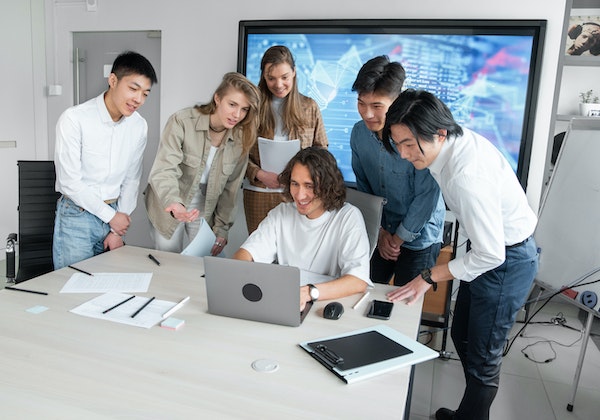
Every organization is a living, breathing organism—a microcosm of personalities, ideas, and agendas all vying for attention. In this constantly evolving global business environment, team collaboration is more critical than ever for innovation. Yet many companies struggle to consistently innovate successfully.
In my recent interview with Jim Kalbach, Chief Evangelist at Mural, we delved deep into the world of remote innovation and team collaboration. Previously, collaboration often arose organically from the physical office space. Water cooler chats, lunchtime discussions, spontaneous meetings—these interactions formed a web of connection, underpinning an innovative team. However, the significant shift to remote work disrupted these connections, posing a new question: how do you maintain and foster team connections in a remote setting?
Let’s dive into this topic and explore how psychological safety forms the foundation for creativity and innovation in remote teams. It’s a topic I often discuss with clients figuring out their hybrid work policy, and Kalbach had some useful insights I’ll be bringing back to my clients.
Remote Connection: The Importance of Intentionality and Consistency
As Kalbach emphasized, team connection is not about friendship or camaraderie, but rather an intentional and enhanced form of relationship that cultivates innovation. This level of connection isn’t born out of infrequent company retreats or grand events; it’s the result of small, consistent rituals incorporated into everyday interactions.
While company retreats have their place—allowing team members to understand each other better and interpret remote communication more effectively—it’s the “small multiples” that make a significant difference in a remote setting. Regular check-ins before a meeting, for instance, can bridge the distance between team members. Simple questions like, “How do you feel today on a scale of 1-10?” or “What did you do over the weekend?” can form the basis of these connections and contribute to an overall sense of psychological safety.
Fostering Creativity: The Interplay of Connection and Trust
Drawing from Kalbach’s perspective, creativity thrives in an environment of trust and psychological safety. This environment is one where people feel free to express their ideas without fear of negative consequences. This notion of psychological safety is rooted in trust, a key component of team connection.
However, the journey to building trust is not paved with displays of competence—it’s constructed with vulnerability. When team members share their fears, admit uncertainties, and show vulnerability, they sow the seeds of trust. These small instances of vulnerability, coupled with regular check-ins, foster the trust needed to fuel creativity.
Yet, trust and connection are not the only ways to facilitate remote innovation. Kalbach pointed to methods that allow innovation even in a “trustless” setting. Techniques like anonymously contributing and evaluating ideas can provide a platform for creativity, sidestepping the need for trust or hierarchical influence. This approach emphasizes the merit of the idea, reducing potential biases related to status or personality.
The Role of Mural in Remote Innovation
Mural, a cloud-based application, serves as a virtual canvas for teams to visually map out their thoughts and ideas. Much like Google Maps, Mural offers a zoomable, pan-able space where teams can jot down thoughts, create clusters of ideas, and collaboratively work with a spatial effect.
As Kalbach highlighted, this shared, virtual space encourages all team members to contribute simultaneously, sparking collective creativity and problem-solving. With Mural, the nonlinear, often chaotic flow of creativity can be visualized and structured in an engaging and collaborative way.
Importantly, Mural includes features like a private mode, promoting anonymity when contributing and assessing ideas. This tool bolsters psychological safety, permitting individuals to voice their ideas without fear of being personally scrutinized.
Leveraging Remote Innovation
From my insightful conversation with Kalbach, it’s clear that fostering innovation in a remote work setting requires intentional effort and a shift in perspective. As Kalbach said, “Creativity isn’t tied to a location. It is tied to human connection, psychological safety, and trust.”
By leveraging tools like Mural and nurturing the right culture, remote teams have a unique opportunity to unlock a wealth of creativity and innovation. Whether through anonymous contributions, fostering trust, or creating spaces for connection, remote teams can redefine the pathway to innovation. The key lies in intentionality—being deliberate about cultivating a culture that values and nourishes these crucial elements.
Key Take-Away
Psychological safety and intentional team connections foster creativity and innovation in remote work settings, aided by tools like Mural...>Click to tweet
Image credit: Mikhail Nilov/Pexels
Originally published in Disaster Avoidance Experts on May 11, 2023




